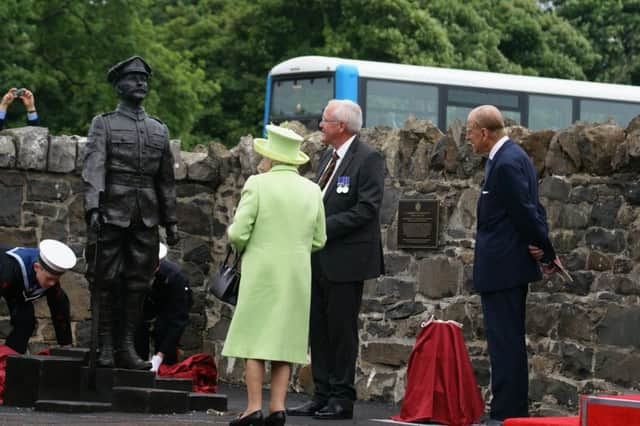Roamer: The Queen and the Duke of Edinburgh meet the statue of a hero they met in 1953


Set on a bronze plinth of seven hexagonal ‘Giant’s Causeway’ stones, Sergeant Quigg’s statue faces the town’s war memorial in the nearby Diamond, awaiting Friday’s centenary commemorations of the Battle of the Somme.
Early on Monday morning a crane set the statue on its freshly prepared site across the road from a row of cottages built by the Macnaghten family in the early 19 th century for retired estate workers.
Advertisement
Hide AdAdvertisement
Hide AdQuigg worked for the Macnaghtens, and was awarded his V.C. for rescuing seven wounded comrades whilst searching for Lieutenant Sir Harry Macnaghten.
“Robert is standing at attention looking respectfully towards the memorial commemorating his 103 dead comrades,” said the historic Rifleman’s great nephew Leonard Quigg, after he’d double-checked the monument’s exact positioning with
sculptor David Annand.
In his book First Day of the Somme historian Martin Middlebrook recounts that by the end of the day on July 1, 2016 “21,000 soldiers from Great Britain, Ireland and the colony of Newfoundland (and South Africa and India) had
been killed or would die of wounds.”
They came from Ireland, north and south, and on Friday every corner of our island will echo with sadness from a century ago.
Advertisement
Hide AdAdvertisement
Hide AdThe first day of unimaginable carnage and horror at the Somme - a 141-day battle that left over one million dead and wounded on all sides - was the most tragic.
As the British soldiers advanced they were mown down by machine gun, rifle fire, mines and shells, making it the bloodiest 24 hours in the history of the British Army.
During the night, Sergeant Robert Quigg’s courageous actions earned him a V.C.
The Bushmills-hero’s story has oft been mentioned on this page, more so since a local Commemoration Society began to raise funds for his statue four years ago.
Advertisement
Hide AdAdvertisement
Hide AdSculptor David Annand’s bronze masterpiece is the ‘story come home’ a century after Rifleman Quigg “then aged 31, went out - in the face of heavy shell and machinegun fire - seven times in search of his platoon officer, each time
bringing back a wounded comrade” wrote Lord Ashcroft K.C.M.G., P.C, who has built up the world’s largest collection of V.Cs for public display.
“Robert Quigg was a modest man from humble origins,” Lord Ashcroft recounted, “yet he deserves his place amongst that rare breed of men who are entitled to be described as ‘the bravest of the brave’”
The statue’s plinth of seven stones is a bronze parable commemorating the seven men who Quigg rescued from certain death on no-man’s land.
Advertisement
Hide AdAdvertisement
Hide AdOver 500 joined up from the Bushmills area for WWI. 103 never came home.
Of those 103 fatalities 26 occurred on July 1, 1916 when the 36th (Ulster) Division advanced on the enemy.
The statue faces their memorial, and its hexagonal plinth- stones also represent the hero’s childhood home close to one of our greatest landmarks.
“He looked from his home to the Causeway,” explained great nephew Leonard, “where his father was a part time tour guide.”
Advertisement
Hide AdAdvertisement
Hide AdThe statue’s backdrop is the trees and the hills of the Macnaghten estate that Robert knew so well.
Four years ago local war-historian Robert Thompson mooted his long-held dream of a statue of Quigg with museum manager Keith Beattie.
“You made a good job of the rifle,” Robert complimented David Annand on Monday after the sculptor had completed drilling four deep bolt-holes that would anchor Quigg’s plinth.
“It’s moulded from a real Lee Enfield standard-issue WWI gun,” Annand explained.
Advertisement
Hide AdAdvertisement
Hide AdThe Victoria Cross on Quigg’s chest is also moulded from a real V.C.
The number 1195 is carved on his bayonet scabbard, Giant’s Causeway L.O.L’s official number, where Robert was an enthusiastic Orangeman and bandsman.
“And he’s in his Royal Irish Rifles uniform,” said Leonard, who refers to his great-uncle Robert as ‘a’ Bushmills hero because “he was just one of hundreds of heroes from the area who unhesitatingly volunteered for service with the British Army.”
Robert went into no-man’s land searching for Second Lieutenant Sir Harry Macnaghten, his employer back in Bushmills, who’d fallen in the first wave of attacks on the first day of the Somme.
Advertisement
Hide AdAdvertisement
Hide AdSuch was the carnage that the British were ordered back by their commanders to their trenches.
Lieutenant-Colonel Bull, Commanding Officer of Robert’s 12th Battalion, later reported “Sir Harry got out of his trench to order the men not to retire, but to come on, and he was shot in the legs by a German machine gun only a few yards away and fell.”
A soldier later reported Sir Harry being taken prisoner by three German soldiers and “being carried away.”
Robert Quigg only stopped searching for Sir Harry in the blood-soaked mud when he was ordered to do so.
Advertisement
Hide AdAdvertisement
Hide AdHe went out seven times in as many hours looking for him and returned each time with a wounded comrade.
The Queen met Robert Quigg V.C. in Coleraine in 1953.
Yesterday, when his statue was unveiled and dedicated, she followed a commemorative order of service that was printed on the back cover with his photograph, and with the words “Sergeant Robert Quigg V.C. ‘Sometimes ordinary men can
do extraordinary things.’”